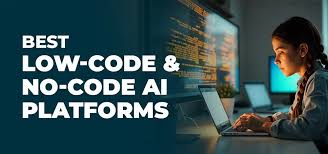Coding vs. No-Coding AI: What's Best for Beginners?
This article explores the differences between coding and no-coding AI for beginners. It weighs the benefits and drawbacks of both approaches, helping newcomers choose the best path depending on their goals, whether for rapid prototyping or deeper technical understanding.
EDUCATION


Artificial intelligence (AI) is revolutionizing industries, from healthcare to finance, making it a sought-after skill for professionals and hobbyists alike. For beginners eager to dive into AI, one crucial question arises: Should you start with coding-based AI tools or no-coding platforms? This blog post will explore both paths, highlighting their pros and cons to help you decide which approach suits your goals.
Understanding Coding AI
Coding AI involves programming AI models from scratch or using open-source frameworks like TensorFlow, PyTorch, or Scikit-learn. It requires foundational knowledge of programming languages such as Python or R, as well as an understanding of machine learning (ML) concepts.
Pros of Coding AI:
Customizability: Coding allows complete control over the architecture and parameters of your models, making it ideal for advanced projects.
Deep Understanding: Learning to code teaches you the inner workings of algorithms and models, which is beneficial for developing robust AI solutions.
Transferable Skills: Programming knowledge can be applied across various domains beyond AI, enhancing your versatility as a developer.
Cons of Coding AI:
Steep Learning Curve: Beginners may feel overwhelmed by the technical complexity of coding.
Time-Consuming: Building models from scratch can be slow, particularly when troubleshooting errors.
Resource-Intensive: Coding often requires powerful hardware and a development environment.
Understanding No-Coding AI
No-coding AI platforms, such as Google AutoML, DataRobot, and Teachable Machine, provide drag-and-drop interfaces to create models without writing code. These tools are designed for accessibility and ease of use.
Pros of No-Coding AI:
Ease of Use: Intuitive interfaces make AI accessible to non-technical users.
Speed: Quickly build and deploy models, often in hours rather than days.
Lower Barrier to Entry: No prior programming knowledge is required, making it ideal for those starting out.
Cons of No-Coding AI:
Limited Customization: You’re restricted to the options provided by the platform.
Less Control: Fine-tuning models or experimenting with unique algorithms can be challenging.
Dependency on Platforms: Reliance on third-party services can limit flexibility and increase costs over time.
What’s Best for Beginners?
The choice between coding and no-coding AI depends on your goals, resources, and how you prefer to learn.
Start with No-Coding AI If:
You’re a non-technical professional looking to integrate AI into your work.
You want quick, practical results without delving into complex algorithms.
You’re exploring AI as a hobby or side project.
Start with Coding AI If:
You’re interested in a long-term career in AI or machine learning.
You want a deep understanding of how AI models work.
You’re prepared to invest time and effort into learning programming and ML concepts.
Bridging the Gap: Combining Both Approaches
For many learners, a hybrid approach works best. Start with no-coding tools to grasp the basics of AI and build confidence. Once you understand key concepts, transition to coding to unlock advanced possibilities. Platforms like Google Colab and Kaggle offer beginner-friendly coding environments with pre-built examples to ease the transition.
Conclusion
Both coding and no-coding AI offer unique advantages for beginners. If you're eager to experiment and see results quickly, no-coding platforms provide an excellent starting point. However, if you're aiming for a deeper dive into AI development and aspire to a career in the field, learning to code is a must.
Whichever path you choose, the most important step is to get started. AI is a vast and evolving field, and every skill you gain along the way brings you closer to mastering it.
Ready to embark on your AI journey? Share your experience in the comments below!
Read more: "How to Introduce Kids to AI: Fun and Easy Learning Tools".